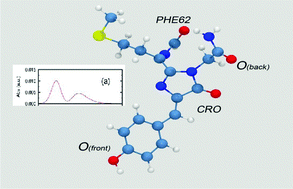Molecular modelling of the pH influence in the geometry and the absorbance spectrum of near-infrared TagRFP675 fluorescent protein†
Abstract
Classical molecular dynamics (MD) simulations are carried out for the recently developed TagRFP675 fluorescent protein (FP), which is specifically designed to fully absorb and emit in the near infrared (NIR) region of the electromagnetic spectrum. Since the X-ray data of TagRFP675 reveal that the chromophore exists in both the cis and trans configuration and it can also be neutral (protonated) or anionic (deprotonated) depending on the pH of the media, a total of 8 molecular dynamic simulations have been run to simulate all the possible states of the chromophore. Time-dependent DFT (TDDFT) single point calculations are performed at selected points along the simulation to theoretically mimic the absorption spectrum of the protein. Our simulations compare well (within the expected error of the computational method) with the experimental results. Our theoretical procedure allows for an analysis of the molecular orbitals involved in the lowest energy electronic excitations of the chromophore and, more interestingly, for a full analysis of the H-bond interactions between the chromophore and its surrounding residues and solvent (water) molecules. This study does not support the hypothesis, exclusively based on the analysis of X-ray data, that the isomerization of nearby residues provokes the rearrangement of the hydrogen bonds in the chromophore's immediate environment leading to the observed red shift of the absorption bands at higher pHs. Instead, we attribute this shift mainly to the superposition of bands of the neutral and anionic chromophores that are expected to coexist at almost the full range of pHs experimentally analyzed. An additional factor that could contribute to this shift is the experimentally observed increase of the cis configuration of the chromophore at higher pHs.


 Please wait while we load your content...
Please wait while we load your content...